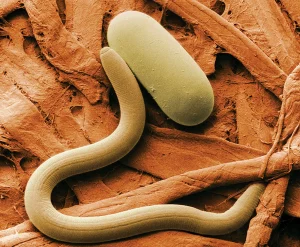ForumIAS announcing GS Foundation Program for UPSC CSE 2025-26 from 27th May. Click Here for more information.
Source-This post on New Nematode Species Steinernema adamsi has been created based on the article “Discovery of new nematode species that could protect crops without pesticides” published in “PHYS.ORG” on 8 February 2024.
Why in the news?
Scientists have found a new species of nematode, Steinernema adamsi, that can help in the battle against crop pests.
About Nematodes

Introduction-Nematodes are roundworms and their size can vary from a tiny 0.2 millimetre to a few metres. They are among the most abundant animals on Earth.
Forms-They occur as parasites in animals and plants or as free-living forms in soil, fresh water, marine environments.
Features-Nematodes are bilaterally symmetrical, elongate, and usually tapered at both ends
Distribution of population-They have been reported from every continent on earth and occur in deserts, swamps, the oceans, the tropics and Antarctica. They can be found even in unusual places like vinegar, beer malts, and water-filled cracks deep within Earth’s crust.
Diseases-They can cause a variety of diseases (such as filariasis, ascariasis, and trichinosis) and parasitize many crop plants and domesticated animals.
Significance of Nematodes
1) These nematodes play a crucial role in the environment as they are responsible for production of about 19% of ammonia of the soil.
2) They are also important bioindicators of soil ecosystem health.
3) They feed on bacteria, fungi, or other microscopic creatures. Thus, they are a major component of soil and sediment ecosystems.
About Steinernema adamsi
Introduction-This new species is a member of a family of nematodes called Steinernema.It were first discovered in the 1920s.
Characteristics-It is an entomopathogenic nematode that crawls inside an insect. It defecates highly pathogenic bacteria into its blood. It then combines with that bacterium to kill the insect host.
Significance-1) Steinernema are not harmful to humans or other mammals.
2) They can help in battle against crop pest because it can infect and kill insect pests.
NOTE-Entomopathogenic-It means “causing disease to insects.”
UPSC Syllabus-Environment.




